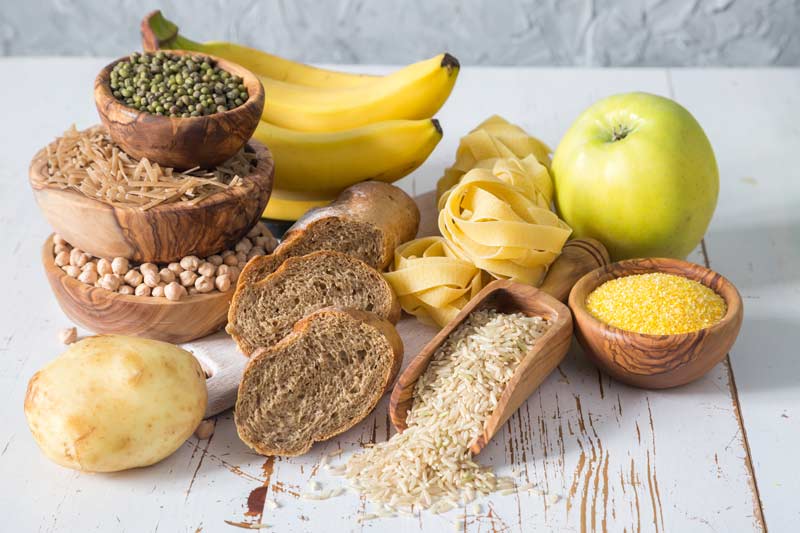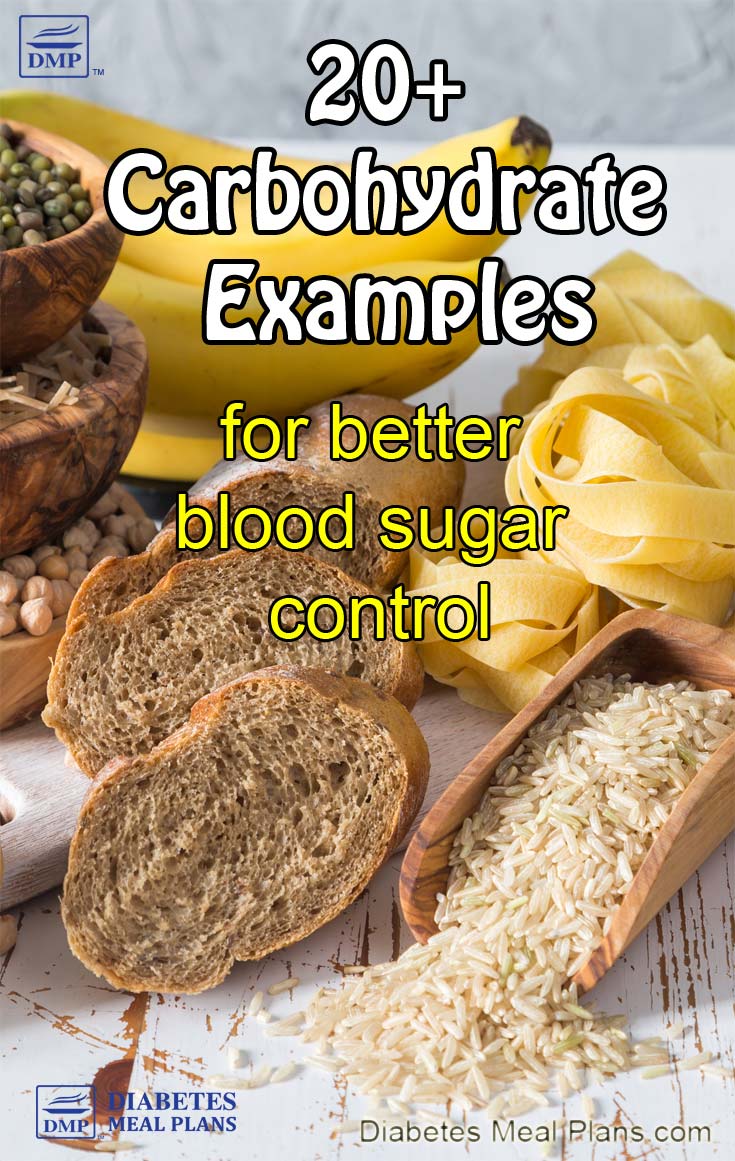Table of Contents[Hide][Show]
Carbohydrates are the nutrient that has the greatest impact on your blood sugar and A1c levels. And perhaps you’ve discovered that the category of carbohydrates is also one of the most confusing parts of nutrition – you’re not alone!
It can take some time to get your head around. That’s why we created the 30 Day turnaround Program™ – it helps you fast track all the diabetic diet stuff you need to know so you can get results faster too.
In any case, today, let’s look at some carbohydrate examples together. And if you have questions of your own, feel free to leave them below. :)

Complex vs. Simple Carbohydrates
Simple carbs are made up of short chains of sugars that are broken down and absorbed very quickly during digestion.
They provide immediate energy and while eating simple carbs may give you a quick “boost” at first, over time the blood sugar spikes caused by indulging in simple carbs will wreak havoc on your A1c levels and your overall health.
Just by hearing that description, you can probably name some examples of simple carbs right off the top of your head – think soda, candy, and white bread! These foods may feel good in the moment but in the long run they just aren’t worth it.
This is why you want to stick mostly to complex carbohydrates to get your daily fill of energy, alongside proteins and fats, of course.
Complex carbs are made up of longer chains of sugars so they take longer to break down, which means they are absorbed more slowly. This slower absorption results in more stable blood sugar, which is why complex carbs should be your go-to carb source.
However, this is where complex carbs gets a little confusing because starches like corn, potatoes, and whole grains technically fall in the category of complex carbs. But these foods also come loaded with high amounts of carbs (we’re talking over 36 grams of carbs in a single baked potato!), so it’s best to limit or eliminate starches.
The message here is that even though complex carbs are a better choice, the goal is to choose complex carbs that are also low in overall carb content, for instance, low carb fruits and non-starchy vegetables.
In fact, filling half your plate with vegetables at each meal is an excellent way to meet your daily recommendation of carbs and dietary fiber (25-38 g), along with reaping the benefits of all the micronutrients (vitamins and minerals) that non-starchy veggies have to offer – delicious and nutritious!
Still confused? Understandable.
So to help make things simpler, let’s go over a basic breakdown of “bad carbs” (aka. simple carbs and high carb foods) that you want to avoid, as well as a list of “good carbs” (aka. the healthy, complex, lower carb foods) that you should eat in abundance.
“Bad” Carbs for Diabetes
By “bad” carbs we’re referring to carbohydrate foods that make it a lot more difficult to lower or regulate blood sugar and A1c levels.
Rice
Whether you’re talking about brown, white, or wild rice, all varieties of this grain are high carb foods. You may be surprised to learn that brown rice actually contains more carbs per serving than white rice does!
Nutrition facts for 1 cup of brown rice:
Calories: 216 | Fat: 1.8 g | Protein: 5.0 g | Total Carbs: 44.8 g | Fiber: 3.5 g | Net Carbs: 41.3 g
Fruit juice
Fruit juice sounds healthy, but the process of juicing actually strips the fruit of its fiber, leaving nothing but pure sugar behind.
Even a single glass of 100% juice can send your blood sugar on a wild ride and contribute to unstable glucose levels throughout the day.
Nutrition facts for 1 cup of grape juice:
Calories: | Fat: 0.2 g | Protein: 1.42 g | Total Carbs: 37.85 g | Fiber: 0.3 g | Net Carbs: 37.55 g
Bread
White, brown, and multi-grain breads are all high carb traps that you want to avoid.
Yes, a whole grain bread may be “less bad” than processed white bread, but most breads and pastries made from traditional flours contain way too many carbs to keep blood sugar levels stable.
Nutrition facts for 1 slice of whole wheat bread:
Calories: 81 | Fat: 1.12 g | Protein: 3.98 g | Total Carbs: 13.67 g | Fiber: 1.9 g | Net Carbs:11.77 g
Table sugar
White table sugar (sucrose) is everywhere in snacks, desserts, soft drinks, and many other products throughout the grocery store.
Drinks like soda are primarily made of plain old sugar (or high fructose corn syrup, which is next on the list) and that sugar consists of pure carbohydrates.
Nutrition facts for 1 12-ounce can of regular cola:
Calories: 150 | Fat: 0 g | Protein: 0 g | Total Carbs: 39.9 g | Fiber: 0 g | Net Carbs: 39.9 g
Corn syrup
The ingredients “corn syrup” and “high fructose corn syrup” are commonly found in sodas, candies, yogurts, breakfast cereals, salad dressings, frozen dinners, snack foods, and more.
These are junk ingredients that are highly processed and are very high in carbs.
Nutrition facts for 1 cup for Minute Maid Lemonade (containing high fructose corn syrup):
Calories: 110 | Fat: 0 g | Protein: 0 g | Total Carbs: 28.99 g | Fiber: 0 g | Net Carbs: 28.99 g
Candy
Candy is on the “no” list for obvious reasons. Sugary chocolates, gummies, lollipops, and all types of candy bars are high in sugar, loaded with unhealthy fats, and nutritionally empty.
Nutrition facts for 1 regular sized Snickers candy bar:
Calories: 280 | Fat: 13.59 g | Protein: 4.29 g | Total Carbs: 35.06 g | Fiber: 1.3 g | Net Carbs: 33.76 g
Wheat flour products
Wheat flour (white or brown) and the products made from it are also high in carbs. These products include breads, cereals, and pastas.
Nutrition for a serving (70 g) of cooked, whole wheat pasta:
Calories: 87 | Fat: 0.38 g | Protein: 3.73 g | Total Carbs: 18.58 g | Fiber: 3.2 g | Net Carbs: 15.38 g
Apples
Apples are the wrong kind of fruit for people with type 2 diabetes because they contain too much sugar and not enough fiber.
But don’t worry; there are plenty of lower carb fruits for you to enjoy… just keep reading to see some examples below.
Nutrition facts for 1 medium apple:
Calories: 95 | Fat: 0.31 g | Protein: 0.47 g | Total Carbs: 25.13 g | Fiber: 4.4 g | Net Carbs: 20.73 g
This is not the extensive list of “bad” high carb foods, but gives you some ideas on where to start.
Please pin, tweet or share; then keep on reading.

“Good” Carbs for Diabetes
By “good” carbs we’re referring to carbohydrate foods that help you to lower or regulate blood sugar and A1c levels.
Eating non-starchy vegetables is the healthiest way to get your daily dose of carbohydrates and fiber. Because they are so low in carbs, you can eat your heart out on many types of vegetables without compromising your blood sugar or A1c levels.
Here are a few examples of ideal vegetables for snacking on and cooking with:
Arugula (rocket)
Nutrition facts for ½ cup of arugula:
Calories: 2 | Fat: 0.07 g | Protein: 0.26 g | Total Carbs: 0.36 g | Fiber: 0.2 g | Net Carbs: 0.16 g
Bok choy (Chinese cabbage)
Nutrition facts for 109 g of bok choy:
Calories: 12 | Fat: 0.15 g | Protein: 0.91 g | Total Carbs: 2.45 g | Fiber: 0.9 g | Net Carbs: 1.55 g
Cucumber
Nutrition facts for ½ cup (52 g) of cucumber:
Calories: 8 | Fat: 0.06 g | Protein: 0.34 g | Total Carbs: 1.89 g | Fiber: 0.3 g | Net Carbs: 1.59 g
Bell peppers
Nutrition facts for 1 medium sweet red pepper:
Calories: 37 | Fat: 0.36 g | Protein: 1.18 g | Total Carbs: 7.18 g | Fiber: 2.5 g | Net Carbs: 4.68 g
Sugar snap peas (snow peas)
Nutrition facts for 50 g of peas:
Calories: 16 | Fat: 0.11 g | Protein: 0.92 g | Total Carbs: 3.48 g | Fiber: 1.4 g | Net Carbs: 2.08 g
As you can see, while the high carb foods are pushing 18 to 40 grams of carbs per serve, these lower carb veggies are just 0.5 to 7 grams of carbs – a big difference, right?
It is also perfectly fine to include low carb fruits into your diet, in limited portions. The following fruits are low in sugar and contain ample fiber, as well as plenty of essential vitamins and minerals.
Strawberries
Nutrition facts for ½ cup of fresh strawberries:
Calories: 24 | Fat: 0.23 g | Protein: 0.51 g | Total Carbs: 5.5 g | Fiber: 1.2 g | Net Carbs: 4.3 g
Raspberries
Nutrition facts for ½ cup for fresh raspberries:
Calories: 32 | Fat: 0.40 g | Protein: 0.74 g | Total Carbs: 7.34 g | Fiber: 4.0 g | Net Carbs: 3.3 g
Blackberries
Nutrition for ½ cup of fresh blueberries:
Calories: 31 | Fat: 0.35 g | Protein: 1.0 g | Total Carbs: 6.92 g | Fiber: 3.8 g | Net Carbs: 3.12 g
Compare these lower carb fruits with 5 to 7 grams of carbs to an apple with 25 grams of carbs and you can see how your choice of fruit can make a big difference to blood sugar levels.
Because here’s the thing to keep in mind: while the type of carbs you eat is important, the amount you eat has the greatest influence on your numbers.
When you cut out or dramatically reduce the amount of carbs you consume, you will lower your numbers. It’s not rocket science, it’s a pretty simple equation!
Use the above carbohydrate examples to help you understand what choices to make to get better results. And if you’re still confused, take the 30 Day Turnaround Program™ – our step-by-step nutrition program goes through carbs and other diabetic diet factors in detail. The program is designed to help you get better results. And we’re proud to say the program is truly helping people turn their lives around!

If you have questions about carbs, feel free to ask them below.
Please pin, tweet or share this info to help others – thanks!

Dave
You dont mention apples v oranges. Are they both bad?
Emily - Dietitian (MS, RD)
Both of those fruits are pretty high in sugar/carbs and we would encourage you to stay clear of them. This article will give you some ideas for better fruits to pick from.
Aslam khan
Very useful and benficial information for diabetic patients. Thankyou
SYED ARIFF
VERY.VERY USFULL TIPS TO DIABETIC PATIENT.LOT OF THANKS.
Emily - Dietitian (MS, RD)
Glad you found the information valuable!